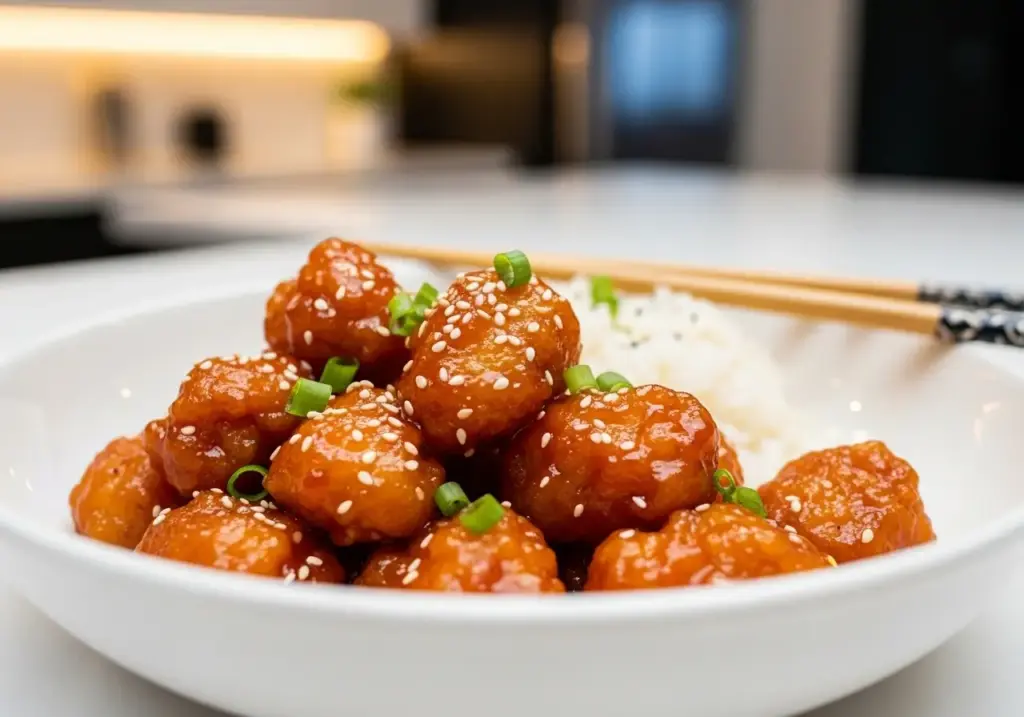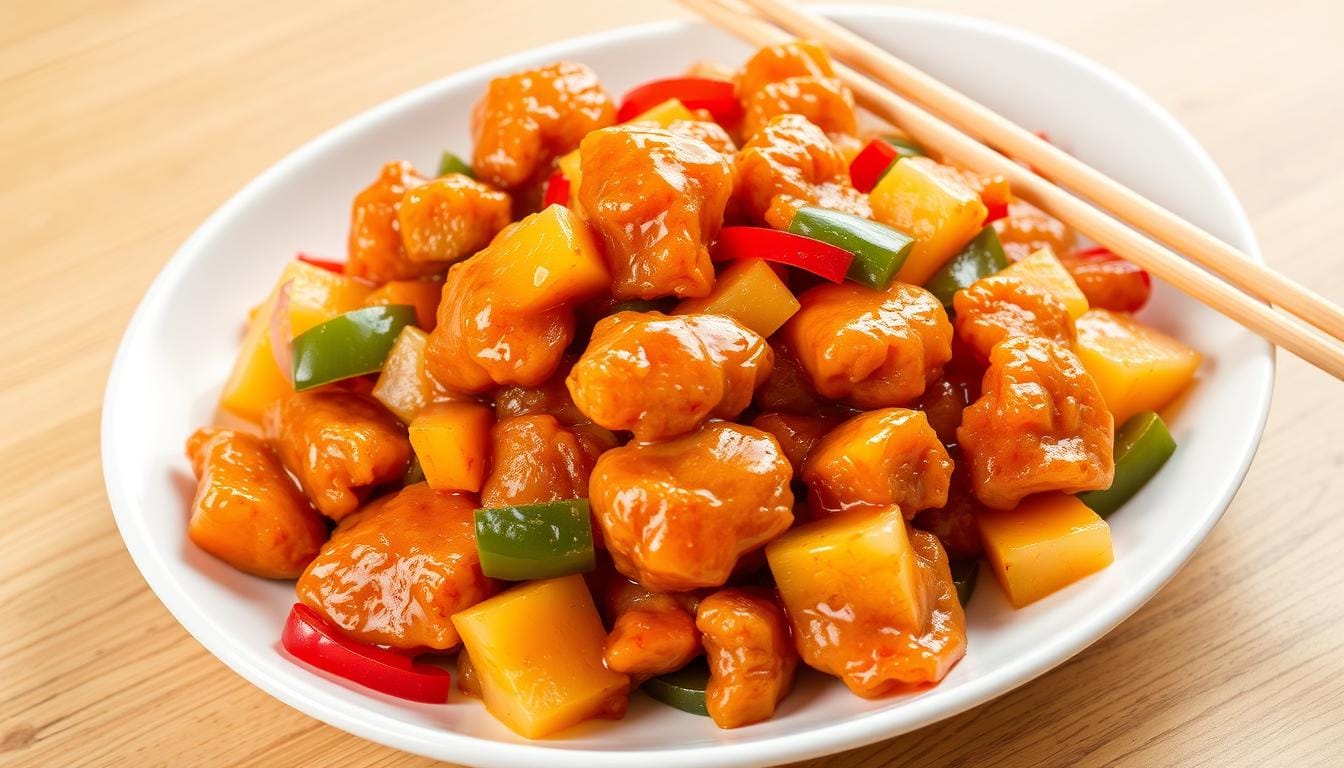I’ll be honest—sweet and sour chicken was one of those takeout staples I ordered way too often before I actually learned what was in it. You know that moment when you’re scrolling through a delivery app at 8 PM on a Tuesday, exhausted from work, and those crispy, glossy chunks of chicken in that tangy-sweet sauce just call your name? Yeah, that was me. Every. Single. Week.
But then I started making it at home, and let me tell you, understanding the nutrition behind this dish completely changed how I approach it. Not in a scary, restrictive way—more like an empowering “oh, I can actually make this work for me” kind of way.
What’s Actually in Sweet and Sour Chicken?
Let’s break down what you’re really eating when you dig into a typical serving of sweet and sour chicken. And trust me on this one—the numbers can vary wildly depending on whether you’re getting takeout, making it from scratch, or using a shortcuts recipe like mine.
A standard restaurant serving (about 1.5 cups) typically contains:
- Calories: 400-600 calories
- Protein: 20-25 grams
- Carbohydrates: 50-70 grams
- Fat: 15-25 grams
- Sugar: 25-40 grams
- Sodium: 800-1,200 mg
Honestly, I was shocked the first time I really looked at these numbers. That sugar content? Whew. Most of it comes from the sauce—pineapple juice, sugar, and sometimes high-fructose corn syrup all team up to create that signature sticky-sweet coating we love.
The Breading and Frying Factor
Here’s where things get interesting. That crispy, golden exterior? It’s delicious, but it’s also where a huge chunk of the calories and fat come from. Traditional sweet and sour chicken gets double-dredged in cornstarch and flour, then deep-fried until it’s practically armor-plated with crunch.
I learned this the hard way when I tried making it for the first time in my tiny Portland kitchen. My apartment smelled like a Chinese restaurant for three days. (Jamie loved it, Cilantro the cat was deeply suspicious, and I was picking up flour from corners I didn’t even know existed.)
The frying process can add anywhere from 100-200 extra calories per serving, depending on how much oil the coating absorbs. And if you’re getting takeout, there’s really no way to know how fresh that oil is or how many times it’s been reused.
The Sauce: Sweet, Sour, and Sneaky
The sauce is where the magic happens—and also where most of the sugar lives. A typical sweet and sour sauce recipe uses:
- Pineapple juice (natural sugars)
- White or brown sugar (about 2-4 tablespoons per batch)
- Rice vinegar or white vinegar (the “sour” part)
- Ketchup (yes, more sugar)
- Soy sauce (hello, sodium)
- Cornstarch for thickening
When I make it at home, I’ve found I can cut the sugar by about a third without anyone even noticing. The pineapple juice brings enough sweetness on its own, and honestly, I prefer the balance when it’s a little less candy-sweet. Your kitchen will smell absolutely incredible while that sauce simmers, by the way—tangy and bright with just a hint of caramel from the reduced sugars.
Making It Healthier Without Losing the Soul
Look, I’m not here to tell you to never enjoy restaurant sweet and sour chicken again. Life’s too short for that kind of food guilt. But I am here to share some tricks I’ve learned for lightening it up when I make it at home.
Protein Tweaks: Instead of deep-frying, I bake the chicken at 425°F until it’s crispy. It’s not quite the same texture, sure, but it cuts the fat content by at least half. I’ve also made this with shrimp (cooks faster, fewer calories) and even baked tofu for my vegetarian friends. Both work beautifully.
If you’re looking for more ways to work with chicken breast, my baked chicken breast guide walks you through getting perfectly juicy results every time—super helpful when you’re trying to keep things on the lighter side.
Sauce Adjustments: I use fresh pineapple chunks instead of canned—less syrupy sweetness, more actual fruit flavor. And I dial back the added sugar to just 1-2 tablespoons. The trick is to taste as you go. If it’s too tart, add a tiny drizzle of honey. Too sweet? Hit it with more rice vinegar. Don’t worry if it looks messy while you’re adjusting—mine always does!
Veggie Boost: This is where you can really make the dish work harder for you nutritionally. I load mine up with bell peppers (all the colors, because why not?), snap peas, and onions. More vegetables means more volume, more fiber, and honestly, more interesting texture. Plus, it makes the whole thing feel less like fried chicken with sauce and more like an actual balanced meal.
Comparing Homemade vs. Takeout
Here’s roughly how my healthier homemade version stacks up against typical restaurant sweet and sour chicken:
My Baked Version (per serving):
- Calories: 320-380
- Protein: 28 grams
- Carbs: 38 grams
- Fat: 8 grams
- Sugar: 15 grams
- Sodium: 550 mg
See that difference? By baking instead of frying and cutting the sugar in the sauce, I’m saving about 200 calories and half the fat. And I still get to lick the spoon while nobody’s looking.
Portion Size Reality Check
Can we talk about portions for a second? Because this is where things get tricky. A restaurant “serving” is often enough for two people—sometimes even three if you’re pairing it with rice and other dishes.
When I make it at home, I actually measure out about 1 to 1.5 cups of the chicken and sauce, then serve it over a small portion of rice (about 3/4 cup cooked) with lots of stir-fried vegetables on the side. That’s usually around 500-600 calories total for a really satisfying dinner.
Trust me, this approach has saved me from that overstuffed feeling I used to get from takeout while still giving me all the flavors I crave.
What About the Rice?
Since sweet and sour chicken almost always comes with rice, let’s factor that in. A cup of cooked white rice adds about:
- 200 calories
- 4 grams protein
- 45 grams carbs
- 0.5 grams fat
I’ve experimented with cauliflower rice (cuts carbs drastically), brown rice (more fiber and nutrients), and even just serving it over a big pile of stir-fried cabbage. Honestly, they all work. The sauce is versatile like that.
If you’re looking for more Asian-inspired chicken dishes that keep things balanced, definitely check out my black pepper chicken recipe. It’s got that same satisfying punch of flavor but with way less sugar and a spice level you can totally control.
My Go-To Serving Strategy
Here’s how I typically serve sweet and sour chicken when I want it to feel indulgent but still relatively balanced:
- The Main Event: 1 to 1.5 cups sweet and sour chicken (my baked version)
- The Base: 3/4 cup cooked jasmine rice or cauliflower rice
- The Side: Big portion of quickly stir-fried bok choy or sugar snap peas
- Total Meal: Around 500-650 calories with tons of protein and vegetables
It’s filling, it’s flavorful, and I don’t spend the rest of the evening in a food coma on the couch. (Though sometimes that’s the vibe too, and that’s totally okay.)
Storage and Meal Prep Considerations
One huge advantage of making this at home? Leftovers that actually reheat well. I’ve learned to store the chicken and sauce separately from the rice—keeps everything from getting soggy. The chicken stays crispy(ish) for about 2-3 days in the fridge, and the sauce keeps for up to a week.
Pro tip I learned from messing this up: don’t sauce all the chicken at once if you’re meal prepping. Keep them separate and combine right before eating. Your reheated chicken will thank you.
Speaking of chicken meal prep, my diced chicken recipes post has a bunch of ideas for turning one batch of cooked chicken into multiple different meals throughout the week. Total game-changer for busy weeknights.

The Bottom Line
Sweet and sour chicken doesn’t have to be a nutritional disaster—it can absolutely fit into a balanced eating pattern, especially when you make it at home and have control over the ingredients. The key is understanding what you’re working with: it’s a dish that’s naturally higher in carbs and sugar because of the sauce and breading, but it also delivers decent protein and can be packed with vegetables.
I learned this trick the hard way after years of ordering takeout and wondering why I felt so sluggish afterward. Now that I make it myself, I can enjoy all those nostalgic flavors while actually feeling good about what I’m eating. And on nights when I do order takeout? I savor every bite without guilt, because balance is what makes food enjoyable in the long run.
Whether you’re tracking macros, just curious about what you’re eating, or looking for ways to make your favorite dishes a little lighter, I hope this breakdown helps. Cooking should be fun and empowering, not stressful. And sweet and sour chicken? It’s always going to be delicious—now you just know how to make it work for you.

Easy Sweet and Sour Chicken Recipe
Ingredients
Method
- Prep the chicken: Preheat your oven to 425°F and line a large baking sheet with parchment paper. In a bowl, mix cornstarch, garlic powder, salt, and pepper. Dip each chicken piece in the beaten eggs, then dredge in the cornstarch mixture until well coated.
- Bake the chicken: Arrange the coated chicken pieces on the prepared baking sheet in a single layer, making sure they don’t touch. Spray lightly with cooking spray. Bake for 20-25 minutes, flipping halfway through, until golden brown and crispy. The internal temperature should reach 165°F.
- Make the sauce: While the chicken bakes, combine pineapple juice, rice vinegar, ketchup, soy sauce, brown sugar, and grated ginger in a medium saucepan. Bring to a simmer over medium heat, stirring occasionally. Once simmering, add the cornstarch slurry and stir constantly for 2-3 minutes until the sauce thickens and becomes glossy. Reduce heat to low.
- Cook the vegetables: In a large skillet or wok, spray with cooking spray and heat over medium-high heat. Add the bell peppers, onion, and minced garlic. Stir-fry for 4-5 minutes until the vegetables are tender-crisp but still have a bit of crunch. Add the pineapple chunks and cook for another minute.
- Combine everything: Add the baked chicken to the skillet with the vegetables. Pour the sauce over everything and toss gently to coat. Cook for 2-3 minutes, stirring occasionally, until everything is heated through and well combined.
- Serve: Serve immediately over rice, cauliflower rice, or your favorite grain. Garnish with sesame seeds and sliced green onions if desired.
Notes
- Use chicken thighs instead of breasts for more flavor and moisture
- Swap chicken for shrimp (reduce baking time to 12-15 minutes)
- Try snap peas or broccoli instead of bell peppers
- Use maple syrup instead of brown sugar for a different sweetness
FAQs
What is sweet and sour chicken?
Sweet and sour chicken is a favorite dish in Chinese-American cuisine. It has crispy fried chicken in a tangy, sweet, and sour sauce. You can make it at home easily.
What are the key ingredients in sweet and sour chicken?
The main ingredients are chicken, vinegar, sugar, ketchup, and pineapple juice. Bell peppers and onions add to the flavor. These ingredients create the dish’s unique taste.
How do I achieve the perfect crispy texture on the chicken?
To get crispy chicken, marinate it in a mix of cornstarch, egg, and seasonings. Then, deep-fry it. This method gives a light, crunchy coating that stays crispy in the sauce.
What type of sauce is used in sweet and sour chicken?
The sauce is made from vinegar, sugar, ketchup, soy sauce, and pineapple juice. The vinegar’s acidity and sugar’s sweetness make the sauce tangy-sweet.
How can I make the sweet and sour sauce healthier?
To make the sauce healthier, use less sugar and lower-sodium soy sauce. Replace pineapple juice with fresh orange juice or mix both. Thicken it with a cornstarch slurry instead of sugar.
What are some good side dishes to serve with sweet and sour chicken?
Good sides include steamed rice, fried rice, and noodles like lo mein or chow mein. Stir-fried vegetables, egg rolls, or spring rolls also make a great meal.
How many calories are in a serving of sweet and sour chicken?
A serving has about 300-400 calories. This depends on the recipe and how it’s made. The amount of oil and sauce used affects the calorie count.
